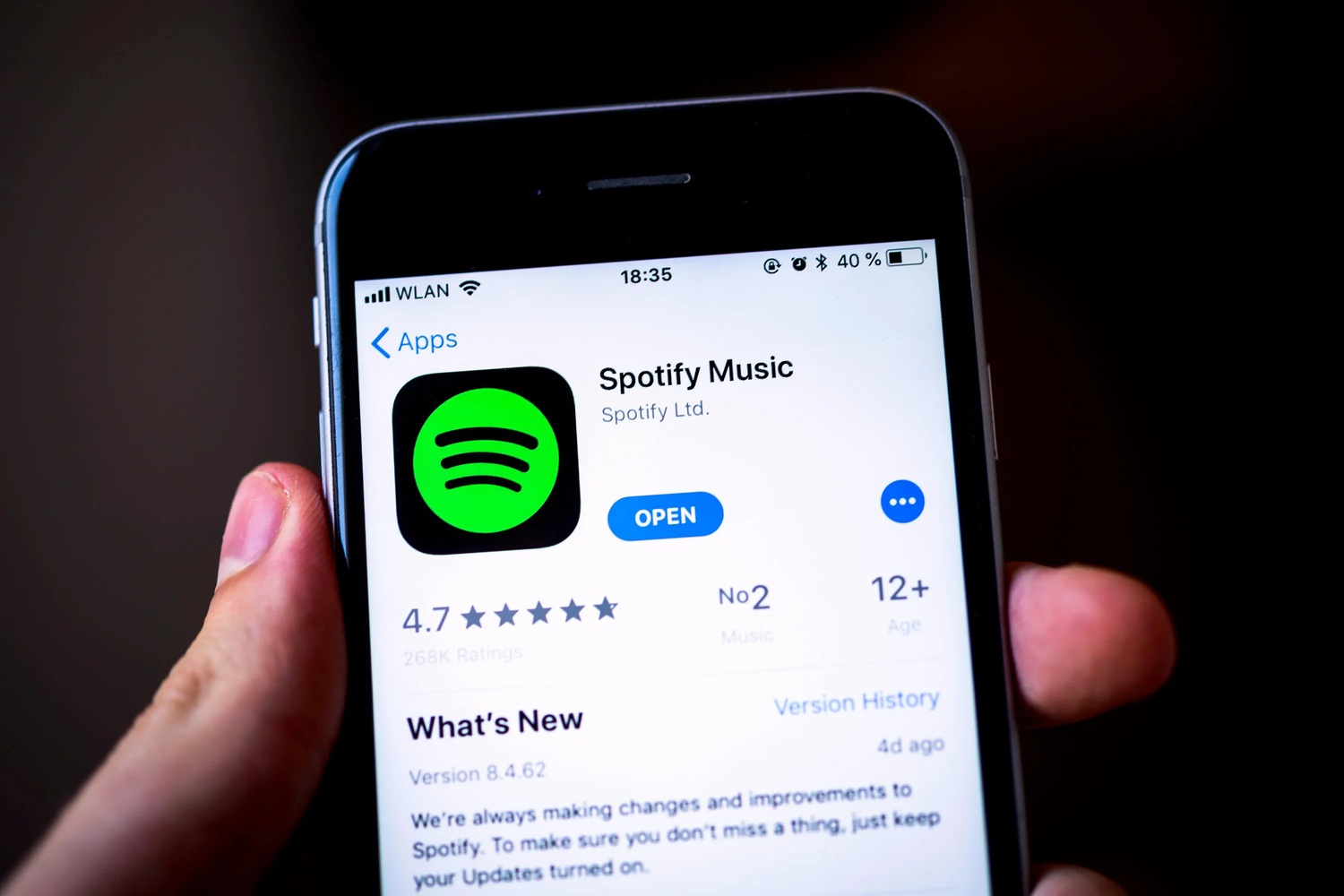Home>Devices & Equipment>Streaming>What Is The Difference Between Downloaded Music And Streaming Music


Streaming
What Is The Difference Between Downloaded Music And Streaming Music
Published: March 8, 2024
Discover the key contrasts between downloaded and streaming music. Learn how streaming services have revolutionized the way we enjoy music. Explore the benefits of streaming over traditional downloads.
(Many of the links in this article redirect to a specific reviewed product. Your purchase of these products through affiliate links helps to generate commission for AudioLover.com, at no extra cost. Learn more)
Table of Contents
- Introduction
- Definition of Downloaded Music
- Definition of Streaming Music
- Quality of Downloaded Music
- Quality of Streaming Music
- Ownership of Downloaded Music
- Ownership of Streaming Music
- Cost of Downloaded Music
- Cost of Streaming Music
- Accessibility of Downloaded Music
- Accessibility of Streaming Music
- Conclusion
Introduction
In today's digital age, music consumption has undergone a significant transformation. With the advent of technology, music enthusiasts now have the option to either download their favorite tunes or stream them online. This shift has sparked a debate regarding the pros and cons of each method. Understanding the fundamental differences between downloaded music and streaming music is crucial for making informed decisions about how we access and enjoy our favorite songs.
Downloading music involves obtaining a digital copy of a song or album from an online platform and storing it on a device for offline playback. On the other hand, streaming music refers to the process of accessing and playing songs directly from an online service without the need for permanent storage on a device. Both methods offer unique advantages and drawbacks, which we will explore in detail to shed light on the nuances of each approach.
As we delve into the intricacies of downloaded and streaming music, it becomes evident that factors such as audio quality, ownership, cost, and accessibility play pivotal roles in shaping the user experience. By examining these aspects, we can gain a comprehensive understanding of the distinct attributes that define downloaded and streaming music. This exploration will empower music enthusiasts to make informed choices that align with their preferences and lifestyle.
The following sections will dissect the key disparities between downloaded music and streaming music, shedding light on the various considerations that influence the decision-making process. By unraveling the intricacies of these two music consumption methods, we aim to equip readers with the knowledge needed to navigate the ever-evolving landscape of digital music with confidence and clarity.
Definition of Downloaded Music
Downloaded music refers to audio files that are obtained from online platforms and saved onto a device for offline playback. This method allows users to purchase individual songs or entire albums, which are then stored in a digital format on their computers, smartphones, or other compatible devices. The process typically involves acquiring music from digital stores or authorized websites, where users can make a one-time payment to obtain permanent access to the content.
One of the defining characteristics of downloaded music is its offline accessibility. Once the music files are downloaded and stored on a device, users can enjoy their favorite songs without requiring an internet connection. This aspect appeals to individuals who prefer to have direct control over their music library and value the convenience of offline playback, especially in environments with limited or no internet access.
Furthermore, downloaded music often comes in various file formats, such as MP3, FLAC, or WAV, allowing users to choose the quality and compatibility that best suits their preferences and devices. This flexibility enables music enthusiasts to curate their collections with high-fidelity audio files, catering to their discerning ears and audio equipment.
Additionally, downloaded music is characterized by its permanence. Once purchased and downloaded, the music files are owned by the user, providing a sense of ownership and control over the acquired content. This ownership aspect distinguishes downloaded music from streaming, as users have the autonomy to manage and transfer their music files across different devices without being reliant on ongoing subscriptions or internet connectivity.
In essence, downloaded music embodies the concept of ownership, offline accessibility, and customizable file formats, offering a tangible and enduring music experience for users who value control over their digital music collections. This method empowers individuals to build personal libraries of their favorite songs and albums, fostering a sense of attachment and autonomy in managing their musical repertoire.
Definition of Streaming Music
Streaming music represents a revolutionary approach to accessing and enjoying a vast array of songs and albums without the need for direct downloads or permanent storage. Unlike downloaded music, which involves acquiring and storing digital music files on a device, streaming music offers instant and on-demand playback of audio content directly from online platforms. This method leverages the power of the internet to provide seamless access to an extensive catalog of music, allowing users to explore, discover, and listen to their favorite tunes with unparalleled convenience.
One of the defining features of streaming music is its real-time delivery and playback. Users can instantly access a diverse range of songs from an extensive library, eliminating the need for manual downloads or local storage. This instantaneous access to a vast repertoire of music empowers listeners to explore new genres, artists, and playlists, fostering a dynamic and immersive music discovery experience.
Furthermore, streaming music is characterized by its adaptive streaming technology, which dynamically adjusts the audio quality based on the user's internet connection and device capabilities. This ensures that listeners can enjoy a seamless and optimized playback experience, regardless of their network conditions or the devices they use. Additionally, streaming platforms often offer curated playlists, personalized recommendations, and algorithm-driven music discovery features, enhancing the overall listening experience and introducing users to new and relevant content based on their preferences.
Another hallmark of streaming music is its subscription-based model, which grants users access to a comprehensive music library in exchange for a recurring fee. This model provides users with the flexibility to explore a vast collection of songs and albums without the need to make individual purchases or manage local storage. Additionally, streaming services often offer offline playback options for subscribers, allowing users to download select content for temporary offline listening, further enhancing the flexibility and accessibility of the streaming experience.
In essence, streaming music embodies the concept of instant access, adaptive playback, and subscription-based convenience, offering a dynamic and ever-expanding music ecosystem for users to engage with. This method empowers music enthusiasts to explore, discover, and enjoy a diverse range of audio content seamlessly, redefining the way we consume and interact with music in the digital era.
Quality of Downloaded Music
The quality of downloaded music is a pivotal consideration for music enthusiasts who prioritize audio fidelity and sonic precision. When users opt to download music, they have the opportunity to select from a range of file formats, each offering distinct audio qualities and compression levels. Common file formats for downloaded music include MP3, FLAC, WAV, and AAC, among others, with each format presenting unique attributes that impact the listening experience.
MP3, a widely utilized format for downloaded music, employs lossy compression to reduce file size while maintaining perceptible audio quality. While MP3 files are convenient for conserving storage space and facilitating easy transfer between devices, they may exhibit subtle loss of audio detail due to compression. On the other hand, formats like FLAC and WAV are renowned for their lossless compression, preserving the original audio data without compromising quality. These formats cater to audiophiles and discerning listeners who prioritize uncompromised sound reproduction and seek to experience music in its purest form.
The quality of downloaded music is also influenced by the source from which the music is obtained. Authorized digital stores and reputable online platforms often offer high-quality, DRM-free music downloads, ensuring that users receive authentic and pristine audio content. This contrasts with unauthorized sources, where downloaded music may be of dubious origin and potentially compromised in terms of quality and authenticity.
Moreover, the ability to customize the bitrate and encoding parameters when downloading music allows users to tailor the audio quality to their preferences and playback devices. This flexibility empowers individuals to strike a balance between file size and audio fidelity, catering to their specific listening environments and equipment capabilities.
In essence, the quality of downloaded music is characterized by its versatility, enabling users to choose from a spectrum of file formats and encoding options to align with their audio preferences and hardware requirements. This diversity empowers music enthusiasts to curate their digital music libraries with precision and cater to their discerning ears, fostering a personalized and immersive listening experience.
The quality of downloaded music is a pivotal consideration for music enthusiasts who prioritize audio fidelity and sonic precision. When users opt to download music, they have the opportunity to select from a range of file formats, each offering distinct audio qualities and compression levels. Common file formats for downloaded music include MP3, FLAC, WAV, and AAC, among others, with each format presenting unique attributes that impact the listening experience.
MP3, a widely utilized format for downloaded music, employs lossy compression to reduce file size while maintaining perceptible audio quality. While MP3 files are convenient for conserving storage space and facilitating easy transfer between devices, they may exhibit subtle loss of audio detail due to compression. On the other hand, formats like FLAC and WAV are renowned for their lossless compression, preserving the original audio data without compromising quality. These formats cater to audiophiles and discerning listeners who prioritize uncompromised sound reproduction and seek to experience music in its purest form.
The quality of downloaded music is also influenced by the source from which the music is obtained. Authorized digital stores and reputable online platforms often offer high-quality, DRM-free music downloads, ensuring that users receive authentic and pristine audio content. This contrasts with unauthorized sources, where downloaded music may be of dubious origin and potentially compromised in terms of quality and authenticity.
Moreover, the ability to customize the bitrate and encoding parameters when downloading music allows users to tailor the audio quality to their preferences and playback devices. This flexibility empowers individuals to strike a balance between file size and audio fidelity, catering to their specific listening environments and equipment capabilities.
In essence, the quality of downloaded music is characterized by its versatility, enabling users to choose from a spectrum of file formats and encoding options to align with their audio preferences and hardware requirements. This diversity empowers music enthusiasts to curate their digital music libraries with precision and cater to their discerning ears, fostering a personalized and immersive listening experience.
Quality of Streaming Music
The quality of streaming music is a critical aspect that significantly influences the listening experience of music enthusiasts. Unlike downloaded music, which offers users the ability to select specific file formats and encoding options to preserve audio fidelity, streaming music leverages adaptive streaming technology to dynamically adjust the audio quality based on the user's internet connection and device capabilities.
Streaming platforms employ advanced algorithms to optimize the audio quality in real time, ensuring a seamless and uninterrupted playback experience for listeners. This adaptive approach allows streaming services to deliver consistent audio performance across a diverse range of network conditions, catering to users with varying internet speeds and bandwidth limitations. As a result, users can enjoy a fluid and uninterrupted music streaming experience without being hindered by fluctuations in network stability.
Furthermore, streaming music services often offer a spectrum of audio quality settings, allowing users to customize the streaming quality based on their preferences and available network resources. This flexibility empowers listeners to strike a balance between audio fidelity and data consumption, catering to their individual priorities and constraints. For instance, users can opt for higher bitrate settings to experience enhanced audio clarity and detail when streaming over robust internet connections, while also having the option to conserve data by selecting lower quality settings in bandwidth-restricted scenarios.
Moreover, the subscription-based model of streaming services grants users access to vast music libraries with a diverse range of audio qualities, spanning from standard quality to high-definition formats. This expansive selection enables users to explore and discover music across different genres and artists, with the flexibility to choose the audio quality that aligns with their preferences and playback devices.
In essence, the quality of streaming music is characterized by its adaptability, customization, and accessibility, offering users a dynamic and tailored audio experience that adapts to their unique listening environments and network conditions. This adaptive approach, coupled with the diverse range of audio quality settings, empowers music enthusiasts to engage with a rich and expansive music ecosystem, redefining the way we consume and appreciate music in the digital era.
Ownership of Downloaded Music
When it comes to ownership, downloaded music offers a tangible and enduring sense of possession and control over the acquired audio content. Unlike streaming music, where access to the music library is contingent upon an active subscription, downloaded music provides users with a distinct level of autonomy and permanence in managing their digital music collections.
Upon purchasing and downloading music from authorized digital stores or reputable online platforms, users effectively acquire ownership of the music files, granting them the freedom to store, transfer, and manage the content across various devices without being tethered to ongoing subscriptions or internet connectivity. This ownership aspect fosters a deep sense of attachment and control, empowering users to curate personalized music libraries that reflect their unique tastes and preferences.
Furthermore, the ownership of downloaded music extends beyond the digital realm, allowing users to create physical backups of their music collections, such as burning CDs or creating offline archives. This physical manifestation of ownership reinforces the enduring nature of downloaded music, providing users with a tangible representation of their musical acquisitions.
Moreover, the ownership of downloaded music transcends the limitations of digital rights management (DRM) often associated with streaming services. DRM-free music downloads, which are prevalent in authorized digital stores, liberate users from restrictive usage policies and enable seamless interoperability across a wide range of devices and platforms. This unrestricted nature of downloaded music ownership empowers users to enjoy their music without encountering compatibility issues or usage constraints, fostering a seamless and immersive listening experience.
In essence, the ownership of downloaded music embodies a profound sense of autonomy, permanence, and flexibility, offering users the freedom to build, manage, and enjoy their digital music collections on their own terms. This ownership paradigm resonates with individuals who value control over their music libraries and seek to establish enduring connections with their favorite songs and albums, transcending the transient nature of streaming access.
Ownership of Streaming Music
When it comes to streaming music, the concept of ownership takes on a nuanced dimension, diverging from the traditional model of possessing tangible music files. Unlike downloaded music, where users acquire permanent ownership of individual songs or albums, streaming music operates within a subscription-based framework, redefining the notion of ownership in the digital music landscape.
In the realm of streaming music, users do not own the individual songs or albums in a traditional sense. Instead, they subscribe to a service that grants access to a vast and ever-expanding music library, allowing them to stream and enjoy a diverse range of audio content on-demand. This subscription-based model introduces a shift from ownership to access, emphasizing the transient and on-demand nature of the streaming experience.
While streaming music does not confer traditional ownership of music files, it offers users a different form of ownership – the ownership of access. Subscribers gain the privilege of exploring and engaging with an extensive catalog of songs and albums, transcending the constraints of physical storage and enabling seamless access to music across various devices and platforms. This ownership of access empowers users to curate personalized playlists, discover new artists, and explore diverse genres, fostering a dynamic and immersive music discovery journey.
Furthermore, the ownership of streaming music is characterized by its fluidity and adaptability. Subscribers can explore new releases, curated playlists, and personalized recommendations, leveraging the platform's expansive music library to tailor their listening experiences. This dynamic ownership paradigm enables users to engage with music in a flexible and evolving manner, aligning with their changing moods, preferences, and discovery journeys.
Additionally, the ownership of streaming music transcends the limitations of physical storage and device dependencies, offering a cloud-based music ecosystem that seamlessly integrates with users' digital lifestyles. This cloud-based ownership paradigm ensures that users can access their favorite songs and playlists from any internet-connected device, transcending the confines of traditional ownership and fostering a borderless and interconnected music experience.
In essence, the ownership of streaming music redefines the traditional concept of ownership, emphasizing access, curation, and adaptability. While users may not possess individual music files, they wield the ownership of access to a vast and dynamic music library, empowering them to immerse themselves in a rich and ever-evolving audio landscape. This ownership paradigm resonates with individuals who value seamless access, diverse exploration, and the freedom to engage with music on their own terms, transcending the confines of traditional ownership models.
Cost of Downloaded Music
The cost of downloaded music encompasses various factors that influence the financial implications of acquiring digital music content. When users opt to download music, they typically encounter a pay-per-download or pay-per-album model, where individual songs or entire albums are available for purchase at set prices. This transactional approach provides users with the flexibility to selectively acquire specific songs or albums based on their preferences, allowing for a tailored and cost-effective music acquisition experience.
Authorized digital stores and reputable online platforms offer a diverse range of pricing options for downloaded music, catering to users with varying budgetary considerations. Additionally, the availability of discounted bundles, promotional offers, and loyalty programs further enhances the affordability and accessibility of downloaded music, enabling users to expand their music libraries without incurring exorbitant expenses.
Furthermore, the cost of downloaded music is influenced by the quality and exclusivity of the content. High-fidelity audio formats and deluxe editions of albums may command higher prices, reflecting the enhanced audio experience and supplementary content offered to discerning listeners. This tiered pricing structure empowers users to make informed decisions based on their audio preferences and budgetary constraints, ensuring that they can access premium music content without compromising on quality.
Moreover, the ownership aspect of downloaded music contributes to its cost-effectiveness over time. Unlike streaming services that require ongoing subscription payments for continued access, downloaded music offers a one-time purchase model, granting users permanent ownership of the acquired content. This ownership paradigm translates to long-term value, as users can build enduring music collections without being subject to recurring fees or access limitations.
In essence, the cost of downloaded music reflects a blend of flexibility, affordability, and enduring value, empowering users to curate personalized music libraries while aligning with their budgetary considerations. This transactional model offers a transparent and tangible approach to acquiring music, ensuring that users can build and expand their digital music collections in a cost-effective and sustainable manner.
Cost of Streaming Music
The cost of streaming music encompasses a dynamic and subscription-based model that redefines the financial dynamics of accessing and enjoying a diverse range of audio content. Unlike the traditional pay-per-download approach associated with downloaded music, streaming music operates within a recurring fee structure, granting users access to an extensive music library in exchange for ongoing subscription payments.
Streaming services offer users a spectrum of subscription tiers, each tailored to accommodate varying budgetary considerations and usage preferences. These tiers often include options for individual subscriptions, family plans, and student discounts, catering to diverse demographics and household dynamics. This tiered pricing model ensures that users can select a subscription tier that aligns with their specific needs, enabling them to access a rich and expansive music ecosystem without incurring excessive costs.
Furthermore, the cost of streaming music is characterized by its value proposition, offering subscribers unparalleled access to a vast catalog of songs, albums, and curated playlists for a fraction of the cost associated with traditional music purchases. This value-driven approach empowers users to explore and discover new music without the financial constraints typically associated with acquiring individual songs or albums, fostering a dynamic and cost-effective music discovery experience.
Additionally, streaming services often provide free, ad-supported tiers that grant users limited access to the music library, further expanding the accessibility of streaming music for individuals who may be hesitant to commit to a paid subscription. This ad-supported model introduces users to the benefits of streaming music at no cost, allowing them to sample the platform's offerings and evaluate the potential value of a premium subscription.
Moreover, the subscription-based nature of streaming music ensures that users can enjoy seamless access to music across various devices, transcending the limitations of physical storage and device dependencies. This borderless and interconnected music experience, coupled with the cost-effective subscription options, empowers users to engage with a diverse range of audio content without being encumbered by individual purchase decisions or ownership considerations.
In essence, the cost of streaming music embodies a paradigm of accessibility, value, and flexibility, offering users an affordable and expansive music ecosystem that adapts to their evolving listening preferences and lifestyle needs. This subscription-based model redefines the financial landscape of music consumption, providing users with unparalleled access to a rich and dynamic music library while aligning with their budgetary considerations and usage patterns.
Accessibility of Downloaded Music
Accessibility of downloaded music encompasses the convenience and flexibility of enjoying music without being reliant on real-time internet connectivity or streaming platforms. When users opt to download music, they gain the advantage of offline accessibility, allowing them to enjoy their favorite songs and albums without the need for continuous internet access. This offline playback capability is particularly valuable in environments with limited or unreliable internet connectivity, such as during travel, outdoor activities, or in areas with restricted network coverage. The ability to store music locally on devices empowers users to curate personalized playlists and enjoy uninterrupted music playback, transcending the constraints of online streaming dependencies.
Furthermore, the accessibility of downloaded music extends to a diverse range of devices, including smartphones, computers, portable media players, and dedicated music playback devices. This cross-device compatibility ensures that users can seamlessly transfer and enjoy their music collections across various platforms, catering to their evolving listening environments and hardware preferences. Additionally, the absence of streaming dependencies liberates users from potential network-related disruptions, ensuring a consistent and reliable music playback experience regardless of their location or connectivity status.
Moreover, the accessibility of downloaded music fosters a sense of autonomy and control over one's music library. Users have the freedom to manage and organize their music files according to their preferences, creating custom folders, playlists, and metadata tags to streamline their music discovery and playback experience. This personalized approach to music organization empowers users to establish enduring connections with their favorite songs and albums, fostering a deeply immersive and tailored music ecosystem.
In essence, the accessibility of downloaded music embodies a paradigm of independence, flexibility, and personalized control, offering users the freedom to enjoy their music collections on their own terms, transcending the limitations of real-time internet dependencies and streaming platforms. This offline accessibility empowers users to curate enduring and personalized music experiences, ensuring that their favorite tunes are readily available across a diverse array of devices and listening environments.
Accessibility of Streaming Music
The accessibility of streaming music represents a paradigm shift in the way users engage with and enjoy a diverse range of audio content. Unlike downloaded music, which offers offline accessibility and local storage, streaming music redefines the concept of accessibility by providing seamless and on-demand access to an extensive music library without the need for direct downloads or physical storage.
One of the defining features of streaming music is its real-time delivery and playback. Users can instantly access a vast repertoire of songs and albums from an online platform, eliminating the need for manual downloads or local storage. This instantaneous access empowers listeners to explore new genres, discover emerging artists, and curate personalized playlists with unparalleled convenience, fostering a dynamic and immersive music discovery experience.
Furthermore, the accessibility of streaming music transcends the constraints of device dependencies and physical storage limitations. Subscribers can seamlessly access their favorite songs and playlists from a diverse array of devices, including smartphones, tablets, smart speakers, and smart TVs, ensuring a borderless and interconnected music experience. This cross-device compatibility enables users to transition seamlessly between different listening environments, adapting to their evolving lifestyle and preferences without being tethered to specific hardware or storage constraints.
Moreover, streaming platforms often offer offline playback options for subscribers, allowing users to download select content for temporary offline listening. This offline accessibility feature enhances the flexibility and convenience of streaming music, catering to users who may encounter limited or intermittent internet connectivity. Whether during travel, outdoor activities, or in areas with restricted network coverage, users can enjoy their favorite music without being reliant on real-time internet access, fostering a versatile and adaptable music consumption experience.
In essence, the accessibility of streaming music embodies a paradigm of seamless access, cross-device compatibility, and on-demand availability, offering users a dynamic and interconnected music ecosystem that adapts to their evolving listening preferences and lifestyle needs. This borderless and on-demand accessibility empowers users to engage with a diverse range of audio content without being encumbered by physical storage limitations or offline dependencies, redefining the way we consume and appreciate music in the digital era.
Conclusion
In conclusion, the distinction between downloaded music and streaming music encompasses a myriad of factors that shape the music consumption experience for users. The choice between these two methods is not merely a matter of accessing audio content but reflects individual preferences, lifestyle considerations, and audio quality priorities.
Downloaded music offers a tangible sense of ownership, offline accessibility, and customizable file formats, catering to users who value autonomy and permanence in managing their music collections. The ability to curate personalized libraries, enjoy high-fidelity audio, and transcend the constraints of real-time internet connectivity resonates with individuals seeking enduring connections with their favorite songs and albums.
On the other hand, streaming music redefines accessibility, offering seamless and on-demand access to an extensive music library without the need for direct downloads or physical storage. The dynamic ownership of access, cross-device compatibility, and adaptive streaming technology empower users to explore, discover, and enjoy a diverse range of audio content, transcending the limitations of traditional ownership models and offline dependencies.
Ultimately, the choice between downloaded music and streaming music hinges on individual preferences, usage patterns, and the desired balance between ownership and accessibility. While downloaded music emphasizes autonomy, permanence, and audio fidelity, streaming music prioritizes seamless access, cross-device flexibility, and dynamic curation. Both methods cater to diverse user needs, providing unique avenues for engaging with music in the digital era.
As the landscape of digital music continues to evolve, the coexistence of downloaded and streaming music reflects the diverse and evolving preferences of music enthusiasts. Whether seeking enduring ownership or dynamic access, users are empowered to engage with music on their own terms, fostering a rich and immersive audio landscape that transcends traditional boundaries and resonates with the ever-changing dynamics of music consumption.











